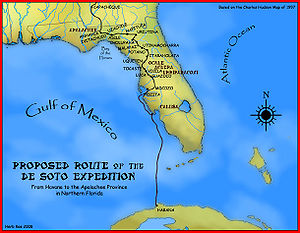
Anhaica
Encyclopedia

Anhaica was an Apalachee
Apalachee
The Apalachee are a Native American people who historically lived in the Florida Panhandle, and now live primarily in the U.S. state of Louisiana. Their historical territory was known to the Spanish colonists as the Apalachee Province...
Indian town and capital of Apalachee Province
Apalachee Province
Apalachee Province was the area in the Panhandle of the present-day U.S. state of Florida inhabited by the Native American peoples known as the Apalachee at the time of European contact. The southernmost extent of the Mississippian culture, the Apalachee lived in what is now Leon County, Wakulla...
located near Myers Park in the present-day city of Tallahassee
Tallahassee, Florida
Tallahassee is the capital of the U.S. state of Florida. It is the county seat and only incorporated municipality in Leon County, and is the 128th largest city in the United States. Tallahassee became the capital of Florida, then the Florida Territory, in 1824. In 2010, the population recorded by...
, Florida
Florida
Florida is a state in the southeastern United States, located on the nation's Atlantic and Gulf coasts. It is bordered to the west by the Gulf of Mexico, to the north by Alabama and Georgia and to the east by the Atlantic Ocean. With a population of 18,801,310 as measured by the 2010 census, it...
. Anhaica's population was approximately 30,000. The province had an estimated population of around 60,000. Anhaica had 250 buildings when Hernando de Soto
Hernando de Soto (explorer)
Hernando de Soto was a Spanish explorer and conquistador who, while leading the first European expedition deep into the territory of the modern-day United States, was the first European documented to have crossed the Mississippi River....
set up camp there in October of 1539 forcing the Apalachee to abandon the village. Hernando de Soto left in March of 1540.
About 1633 the Franciscan Order
Franciscan
Most Franciscans are members of Roman Catholic religious orders founded by Saint Francis of Assisi. Besides Roman Catholic communities, there are also Old Catholic, Anglican, Lutheran, ecumenical and Non-denominational Franciscan communities....
's Mission La Purificacion de Tama established a mission at the former site of Anhaica. The fact that no platform
Platform mound
A platform mound is any earthwork or mound intended to support a structure or activity.-Eastern North America:The indigenous peoples of North America built substructure mounds for well over a thousand years starting in the Archaic period and continuing through the Woodland period...
or pyramid
Pyramid
A pyramid is a structure whose outer surfaces are triangular and converge at a single point. The base of a pyramid can be trilateral, quadrilateral, or any polygon shape, meaning that a pyramid has at least three triangular surfaces...
al mound
Mound
A mound is a general term for an artificial heaped pile of earth, gravel, sand, rocks, or debris. The most common use is in reference to natural earthen formation such as hills and mountains, particularly if they appear artificial. The term may also be applied to any rounded area of topographically...
s are found at Anhaica may indicate a political change. Either Anhiaca was not occupied long or mounds were no longer being built. Also, disease could have been introduced from the Pánfilo de Narváez
Pánfilo de Narváez
Pánfilo de Narváez was a Spanish conqueror and soldier in the Americas. He is most remembered as the leader of two expeditions, one to Mexico in 1520 to oppose Hernán Cortés, and the disastrous Narváez expedition to Florida in 1527....
expedition through Apalachee
Apalachee
The Apalachee are a Native American people who historically lived in the Florida Panhandle, and now live primarily in the U.S. state of Louisiana. Their historical territory was known to the Spanish colonists as the Apalachee Province...
in 1528 reducing population, changing village location and or mound
Mound
A mound is a general term for an artificial heaped pile of earth, gravel, sand, rocks, or debris. The most common use is in reference to natural earthen formation such as hills and mountains, particularly if they appear artificial. The term may also be applied to any rounded area of topographically...
-building activities. Anhaica was rediscovered in 1988 by Florida State archaeologist B. Calvin Jones.
See also
- List of sites and peoples visited by the Hernando de Soto Expedition
- Mississippian cultureMississippian cultureThe Mississippian culture was a mound-building Native American culture that flourished in what is now the Midwestern, Eastern, and Southeastern United States from approximately 800 CE to 1500 CE, varying regionally....
- Southeastern Ceremonial ComplexSoutheastern Ceremonial ComplexThe Southeastern Ceremonial Complex is the name given to the regional stylistic similarity of artifacts, iconography, ceremonies, and mythology of the Mississippian culture that coincided with their adoption of maize agriculture and chiefdom-level complex social organization from...

